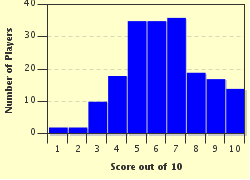Quiz Answer Key and Fun Facts
1. The picture shows the Jamestown Church, built in 1639 and reconstructed in 1907. This stands at the centre of Britain's first permanent overseas colony, James Fort, established in 1607. In which U.S. state can you now visit historic Jamestown?
2. Established in 1565, Saint Augustine in modern-day Florida is recognized as the oldest continuously-occupied European settlement in the New World. Originally called New London and then later renamed St. George's Town, the oldest surviving English settlement (established in 1612) is located on which island?
3. The 1667 Treaty of Breda finalized the end of the Second Anglo-Dutch War. The upshot was that England gained the former Dutch territory of New Netherland, which they renamed New York. Meanwhile, the Dutch kept control of which colony, noted for its rich sugar plantations, that they had captured from the English?
4. Not a multinational banking organization based in London, but the flag of the region known as Rupert's Land or Prince Rupert's Land from 1670 until 1870. Where in the modern-day world was this British territory located?
5. Originally called White Town, Fort Saint George (founded in 1644) was the first English fortress in India. The fortress is now used as the home of the legislature for the state of Tamil Nadu. In which modern-day coastal city is the site of the original fort located?
6. Signed in 1713, the Treaty of Utrecht was a series of documents that established peace at the end of the Spanish War of Succession. Britain acquired Newfoundland, Nova Scotia and part of the Caribbean island of Saint Kitts from the French. Britain also gained the island of Minorca and which other territory from Spain?
7. The picture shows "Canvas Town", temporary home to the thousands who arrived every week following the 1851 gold rush. Which city became the second-richest city in the British Empire, after London, as a result of this discovery of gold?
8. Signed on 6 February 1840, the Treaty of Waitangi gave the indigenous people rights as British subjects and established a British governor in which modern-day country?
9. A treaty signed in 1819 on behalf of the British East India Company with Sultan Hussein Shah of Johor established a trading post, and a further treaty five years later established the region as a British possession. In 1826, it became part of the Straits Settlements and it became the regional capital in 1836. Which Asian city is this?
10. The British Empire began losing its African colonies early in the 20th century, South Africa gaining dominion status in 1910 and Egypt becoming independent in 1922. The Gold Coast became the first sub-Saharan colony to gain independence, as Ghana in 1957. Which was the last British colony in Africa to gain independence?
Source: Author
EnglishJedi
This quiz was reviewed by FunTrivia editor
bloomsby before going online.
Any errors found in FunTrivia content are routinely corrected through our feedback system.

